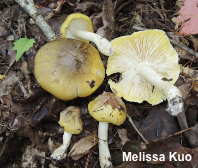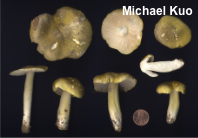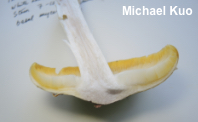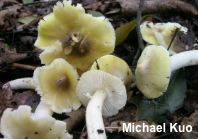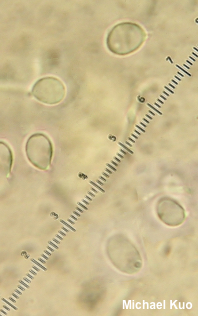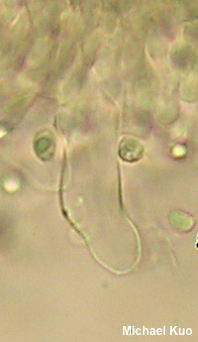| Major Groups > Gilled Mushrooms > Pale-Spored > Tricholoma > Tricholoma sejunctum |

|
Tricholoma sejunctum [ Basidiomycota > Agaricales > Tricholomataceae > Tricholoma . . . ] by Michael Kuo First described from England during the reign of Queen Victoria, Tricholoma sejunctum is a hardwood-associated, yellow green species of Tricholoma that features a moderate covering of slightly darker, radiating, appressed fibrils, along with white gills. Its odor is strongly "farinaceous" (mealy, or cucumber-y) and, under the microscope, it lacks clamp connections. Here in North America, the name Tricholoma sejunctum has been applied very broadly, so that it has encompassed many mushrooms with features deviating somewhat from the original (for example, in having much darker radiating fibrils, or brown caps with no green or yellow shades) and/or with widely different mycorrhizal associations (for example, with conifers). However, it is now clear that it's time to begin the process of putting on the brakes; we appear to have several—even many—North American, sejunctum-like species. So, to do my part, I will narrow my use of the name sejunctum to hardwood-associated, greenish yellow collections that do not have strongly contrasting fibrils radiating from the center—although the center is often somewhat darker in color. It is possible that the collections narrowed down by this rubric are a phylogenetic match for the European Tricholoma sejunctum—but it's not very likely, since transcontinental distribution of oak-associated mycorrhizal species is very rarely upheld by DNA studies (unlike transboreal and montane, conifer- or birch-associated species, which are not uncommon). Exceptions to this "rule" usually involve human interference (see Amanita phalloides for an example). Still, at least my approach will acknowledge the current ecological and morphological boundaries of the species, and provide a little more focus. For the conifer-associated North American sejunctum-like species, see Tricholoma species 03. Description: Ecology: Mycorrhizal with oaks and other hardwoods in temperate zones; growing scattered or gregariously; North American distribution uncertain; late summer and fall. The illustrated and described collections are from Illinois, Kentucky, Michigan, and Missouri. Cap: 4–9 cm; convex with a central bump, becoming broadly convex, broadly bell-shaped, or nearly flat; sticky when fresh and young but soon dry; yellowish to olive yellow, moderately covered with grayish to olive, radiating, appressed fibers (especially over the center); the margin often brighter yellow and somewhat inrolled when young. Gills: Attached to the stem by a notch; close ; short-gills frequent; white, sometimes developing yellow stains toward the cap margin. Stem: 3–10 cm long; 1–1.5 cm thick; equal; bald; dry; whitish, sometimes with yellow tinges, or yellowish overall; basal mycelium white. Flesh: White; not changing when sliced; thick. Odor and Taste: Mealy. Chemical reactions: KOH on cap surface negative. Spore Print: White. Microscopic Features: Spores 5–8 x 3.5–5.5 µm; ellipsoid, with a small apiculus; smooth; hyaline in KOH; inamyloid. Lamellar trama parallel. Cheilocystidia sometimes present; 15–40 x 5–15 µm; clavate, sublageniform, cylindric, or somewhat irregular; thin-walled; smooth; hyaline in KOH. Pleurocystidia not found. Pileipellis an ixocutis; elements 2.5–8 µm wide, brownish walled, smooth or a little encrusted, hyaline in KOH. Clamp connections not found. REFERENCES: (Sowerby, 1799) Quélet, 1872. (Fries, 1821; Saccardo, 1887; Smith, Smith & Weber, 1979; Ovrebo, 1980; Arora, 1986; Lincoff, 1992; Shanks, 1994; Roody, 2003; Miller & Miller, 2006; Trudell & Ammirati, 2009; Christensen & Heilmann-Clausen, 2013; Kuo & Methven, 2014; Desjardin, Wood & Stevens, 2015; Heilmann-Clausen et al., 2017.) Herb. Kuo 09299603, 10020303, 09200810, 10041505. This site contains no information about the edibility or toxicity of mushrooms. |
© MushroomExpert.Com |
|
Cite this page as: Kuo, M. (2019, October). Tricholoma sejunctum. Retrieved from the MushroomExpert.Com Web site: http://www.mushroomexpert.com/tricholoma_sejunctum.html |
